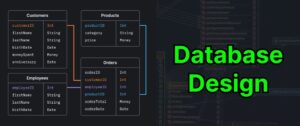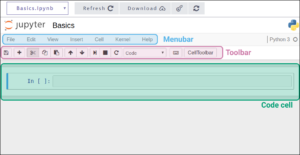
| Term | Description |
|---|---|
| ImportError | This is a built-in exception in Python. It is raised when an import statement fails to find the specified module, or when a from…import cannot find a name that should be imported. |
| Partially Initialized Module | When a module is imported and not completely initialized due to some reasons like Circular Import, it is termed as partially initialized. |
| Circular Import | In Python, a circular import happens when two or more modules depend on each other. That means the first module is trying to import the second one while the second one still needs some code from the first one. |
ImportError: Cannot Import Name ‘…’ From Partially Initialized Module ‘…’ occurs, as suggested by the message, when there is a circular dependency between python modules. This is a very common scenario in coding where module ‘A’ imports some definition from module ‘B’, while at the same time; module ‘B’ tries to import something from module ‘A’.
In Python, this usually isn’t an issue because imports typically are handled at the beginning of the file. However, if you’re using dynamic imports or imports within functions / methods, the script can get into a situation where module ‘A’ is still initializing, module ‘B’ gets loaded, and then ‘B’ attempts to access an attribute of ‘A’ that hasn’t yet been defined or partially initialized.
To resolve this issue, refactoring your code to eliminate circular dependencies such as moving the import statements to a different location in your code or deferring the import until it’s necessary (known as a local import) often helps. Using
import ... as ...
or importing modules instead of items from modules could also solve the problem. Keep in mind that excessive interdependence between modules in a project may indicate it’s time for some architectural decisions about separation of concerns.
References:
Python Official Documentation – Errors and Exceptions
Real Python – Circular Dependencies
Before dive straight into the KeyError, it’s essential you have a clear understanding about how Python’s import system works. When you use an import statement in Python, what you’re actually doing is loading another module into your current program/script so you can access and use its defined names (variables, functions, classes, etc.). This process involves compiling, parsing and running the code of the imported module. Typically, modules are only imported once per interpreter session, unless explicitly reloaded.
Now, let’s understand about ImportError: This exception is raised when an import statement cannot find the specified module or cannot locate a named object in the module. There are two main types of ImportErrors:
- Typographical: The name of the module, function or path is spelled wrong. Happens often, usually easy to fix.
- Structural: Rooted deeper, like a problem with module initialization that triggers an ImportError. For instance, circular imports fall under this category and are trickier to resolve.
A typical example of a “structural ImportError” is the “ImportError: cannot import name ‘..’ from partially initialised module ‘…’ (most likely due to a circular import)” error message. Here, Python indicates that a circular import most likely exists – which refers to a situation where module A imports module B while module B imports module A either directly or indirectly through another module.
Consider the following code structure as an example:
# Module A
import B
class ClassA( object ):
def __init__(self):
self.b = B.ClassB()
# Module B
import A
class ClassB( object ):
def __init__(self):
self.a = A.ClassA()
Because ClassA requires a ClassB instance during creation and vise versa, it’s impracticable for such a structure to exist without falling into an infinite loop of instances creations. That exact situation would cause a circular import.
Here are some suggestions on how to handle such scenarios:
- Redesign Your Modules: Simplify your modules, and aim to reduce interdependence between them. If two modules seem overly dependent on one another, they might be better off combined into a single module.
- Use Import Statements inside Functions/Methods: Instead of doing top-level imports which are executed when the module is loaded, place them inside your functions. This way, they’ll only be imported when needed and could break the cycle of circular imports.
- Implement Lazy Imports: Similar to the previous strategy, except instead of importing within a function, you could implement a method that only imports the module when the resource is used for the first time.
In conclusion, fixing the ImportError due to circular imports involves understanding your code well and refactoring it wisely. Importing only what’s necessary and working towards reducing code complexity will always favor not only debugging, but maintenance and readability as well.
Further readings on this topic can be found:
Python Docs: Importing from a package,
Stack Abuse: Python Circular Imports.
The “
ImportError: Cannot import name '...' from partially initialized module '...'
” error in Python is generally associated with a concept known as circular imports. This phenomenon occurs when you have two or more modules, or files, that are dependent on each other.
Before delving into how to identify and debug these circular imports, let’s understand why this error pops up in Python. To put it simply, the Python interpreter processes the imported file line by line. When it encounters a code that in turn requires importing another module, it jumps to that module and starts interpreting from the top. The problem comes when this other module also has an import statement pointing back to the first module, thereby creating a loop. Since the first module was not fully executed while the interpret jumped to the second, the error message notes it as a ‘
partially initialized module
‘ – hence the ‘circular’ import.
Identifying Circular Imports:
Understanding how to spot these circular imports can be done by imagining your Python files as nodes in a network. When you see a loop among these nodes due to dependency on importing each other, we have a potential for a circular import. Debugging this situation is generally based on breaking this dependency loop, properly ordering your imports, or leveraging Python’s capabilities to handle dynamic imports.
Consider the following example, where we have two Python files,
A.py
and
B.py
. If
A.py
contains:
from B import something_from_B
And vice versa,
B.py
contains:
from A import something_from_A
This situation represents a simple circular import situation.
Debugging Circular Imports:
Several ways may be implemented to resolve these circular scenarios:
1. Refactor Your Code: Look at refactoring your code such that the requires of each file are all defined before they are needed. For instance, in the above example, if
something_from_A
does not depend on
something_from_B
, move
from A import something_from_A
below
something_from_B's
definition in
B.py
.
2. Utilize __init__.py: You can make use of the special Python file
__init__.py
within your package directory containing these cyclic-potential files. By importing necessary components within __init__.py, you can avoid the circular import in individual files.
3. Import Modules Instead Of Specific Object: If you import entire modules instead of specific objects employing
import A
rather than
from A import something_from_A
. Modifying your method calls, you step around Python’s immediate instantiation attempt, side-stepping the potential issue.
4. Dynamic/Deferred Importing: Python standard library doesn’t always need everything to be loaded immediately. So, you can define some functions that contain import statements, and then only call those functions when needed. Do note though, this raw scenario is avoided generally since resulting effects can be difficult to troubleshoot.
All of these methods require careful consideration along with understanding the architecture and dependencies within your codebase.
Here are some additional Python resources to help you familiarize yourself with import handling, principles of Python’s import system (Official Python Docs), and deeper elaboration on circular imports and ways to avoid them (Stackabuse Article).
Remember, coding is about iteration and improvement! Iteratively working through errors like these above can lead to better structured code and improved skill levels.While using Python, you may encounter a circular import problem resulting from trying to import a module that is not fully initialized. This problem usually causes the ImportError: ‘Cannot Import Name ‘…’ From Partially Initialized Module ‘…”. It’s often associated with a wrong architecture design of your modules and misplacement of imports in your Python code.
In order for us to understand the concept of a partially initialized module, here’s a Python code snippet:
# File1.py
import file2
def func1():
file2.func2()
# File2.py
import file1
def func2():
print("Hello World")
This will lead to an error, because while executing File1, it tries to import and run File2. However, File2 attempts to import back into File1, forming a circular dependency. The Python interpreter gets confused due to this cycle, cannot properly initialize the imported modules, leaving them only partially initialized.
To resolve the issue of partially initialized modules and hence avoid circular imports, some good practices include:
– Refactor your code to remove the circular dependency by elaborating your design pattern/structure.
– If two functions from different modules depend on each other, consider whether they can be placed in the same module.
– Use local imports wisely. If the imported module is only used within a function, you can import that module inside that specific function, which reduces the chances of having an initialization conflict at runtime.
This solution works, but it might have performance drawbacks as we’re importing the same module multiple times, and it goes against (The Zen of Python)[https://pep20.org/] principles, specifically its calling for codes to be clean and readability counts. An interesting notion in resolving Python’s circular imports is understanding the difference between “import x” and “from x import y”. Consider the following:
# File3.py
def hello():
print('Hello!')
# File4.py
from file3 import hello
hello()
In this example, once “hello” from file3 is imported into file4, it becomes part of file4’s namespace. Consequently, using “from x import y” can help alleviate circular imports, provided it’s used judiciously.
Like many things related to programming, how to best avoid circular dependencies in your Python code ultimately depends on your program’s design. Taking matters of structure and isolation into consideration when composing your program can certainly keep such troublesome issues at bay.When we encounter the error “Cannot Import Name ‘…’ From Partially Initialized Module ‘…’ (Most Likely Due To A Circular Import)”, it means we are likely experiencing a circular import issue in Python, mainly due to organizing or structuring code in a way that creates a loop within the import statements. The specifics here involve working with imports that hold a dependency on one another in what resembles a circling pattern.
Let me illustrate this issue using an example:
Suppose we have two python files:
File
moduleA.py
:
from moduleB import funcB
def funcA():
...
return value
And file
moduleB.py
:
from moduleA import funcA
def funcB():
...
return value
In these files,
funcA
is a function in
moduleA.py
, which depends on
funcB
from the
moduleB.py
. Conversely,
funcB
in
moduleB.py
depends on
funcA
in the
moduleA.py
. This forms a circular dependency leading to the ImportError.
To fix such errors, there are few methods as follows:
* Re-organizing your imports: One could structure the import statements effectively to avoid any chances of forming a cycle. This often means that you might need to refactor your program design such that each module tends to be more isolated and independent. This technique generally enforces the principle of high cohesion, where related logic is kept together in one module, making it less likely to create multiple dependencies.
* Late imports: In Python, a very common way to avoid circular imports is to move the import statements right into the functions that require them, just when they are needed (Python Software Foundation). This method ensures that an import statement is executed only when necessary.
* Using Importlib: In Python 3.5+, importlib.util.resolve_name can help to avoid mutual imports by resolving the name in a given package (Python Software Foundation).
Using importlib would look something like:
import importlib
class MyClass:
def __init__(self):
moduleB = importlib.import_module("moduleB")
self.funcB = moduleB.funcB
def funcA(self):
...
self.funcB()
Though considered a workaround, note that while Circular Imports can still occur even if you follow best coding practices, it’s always crucial to write clean, maintainable, and well-structured code to prevent such problems from arising in the first place. Carefully managing the dependencies among the different modules of your project is also key to avoiding these issues.The error message “
ImportError: Cannot import name '...' from partially initialized module '...'
” is often due to a circular import issue. Circular import refers to a situation where two or more modules depend on each other, directly or indirectly. The core of the issue lies in the sequence of compilation and import in Python: when Python imports a module, it first checks for compiled byte code, and if none, it starts executing the code until completion.
In a circular dependency case, if module A imports module B and at the same time, module B has a statement importing module A, Python might not have fully executed all statements in module A by the time statements referring to module A are executed in module B. Thus Python interprets module A as “partially initialised”, and hence throws an ImportError exception.
To resolve these issues:
Use import statements for packages and modules only
Rather than importing individual classes or functions, simply import the entire module and refer to items with their corresponding module name.
Below are two hypothetical modules, A and B, illustrating this solution:













